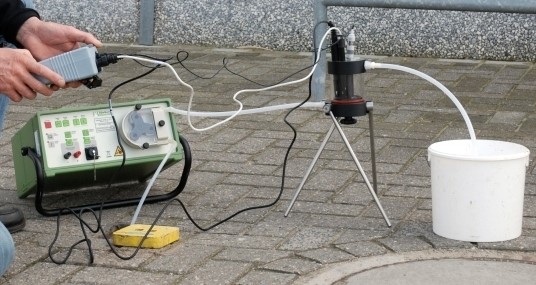

Groundwater sampling & purge techniques – the importance of acquiring a representative sample

April 8, 2015
Representative data is the holy grail of site analysis and modelling. Inaccurate data can lead to incorrect conclusions which could be very costly to land owners, users and developers. Acquiring a representative groundwater sample starts with the correct installation of a well. The aim of a well is to produce water representative of the groundwater surrounding the screened part of the well.
A correctly installed well is a window into the groundwater. A well should be discretely installed so little impact above and below ground. The materials used to construct the well should be certified or from a trustworthy source. Impermeable layers must be sealed and the screened section below minimum groundwater level. See diagram. 
Before sampling from a well it is a requirement that it is purged to remove silty material, deposits from the bottom of the well, stagnant oxidised water and to attract groundwater from the aquifer.
Currently there are three sampling methods: high flow, low flow and no flow sampling. The classical high flow purge method requires purging the well with 3 x wetted well volume so produces large volumes of waste water; creates greater potential for draw down; requires expensive high flow pumps (larger pumps require larger well pipes) and is not so suitable for VOC sampling (heat and cavitation) and generates high turbidity.
High turbidity is not good because if a water sample is filtered containing PAH, PCB, dioxins, microorganisms (E. coli, Giardia) and a number of pesticides none of these components will be found in the sample and if the sample is not filtered, these pollutions adsorb to sediments and are finally analysed as being water pollution! Adsorbed contaminants in suspended sediment can amplify water analysis up to 1000 times!
Low flow sampling or micro-purging requires smaller volumes of waste water, can be deployed in small diameter wells, creates minimal draw down, pump/tubing is positioned in the screen section of the well, can be adjusted to an extremely slow speed (±500ml/minute) and there should be no need to renew (purge) the water in the blind section.
However the benefits of no purge sampling are numerous. As the name suggests no flow sampling requires no water purged prior to sampling so saves on time and the removal and storage of purged water. For groundwater monitoring programs for VOCs no flow sampling can improve the cost effectiveness. Several different studies on cost saving of no flow sampling show savings of 70% – 40% of more traditional sampling methods.
More advantages of no flow sampling are more accurate results, repeatable samples, less time onsite, lower cost and less disruption to site.
There are several equipment options for no flow sampling: the grab method, adsorption and diffusion. At Van Walt we favour the grab method that delivers an equilibrated instantaneous snap shot in time of the groundwater conditions in a well. A grab sampler is deployed in a well and left until the groundwater conditions have re-equilibrated and at that time the sample is captured and sent off to a laboratory for analysis.
For more information click here or call us on +44 (0)1428 661 660.
You might also be interested in...
Van Walt Guidelines for sampling for PFAS in Groundwater
November 13, 2024We need to make clear, that at the time of writing, there are no ISO or EN standards which deal with the sampling of groundwater for PFAS.
Read MoreSpot measurement v. continuous environmental monitoring
August 25, 2023Environmental monitoring has developed considerably over the years. From the time when a consultant went out monthly or quarterly with a dip tape to monitor the groundwater level in a borehole, wind forward...
Read MoreMeasuring Nitrates (NO3, NO3-N) in the field
June 20, 2023The interest in Nitrates is nothing new. One way or another we have been measuring them for half a century.
Read MoreVan Walt Environmental Equipment
A small selection of our environmental equipment
